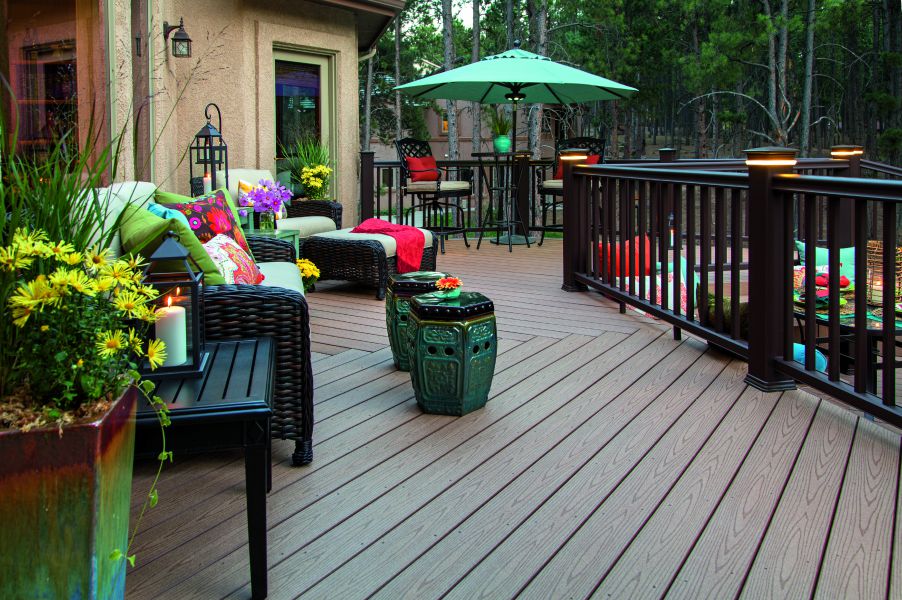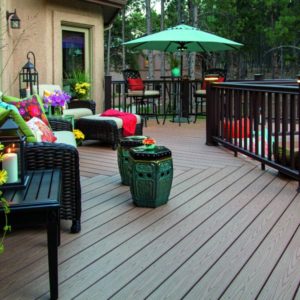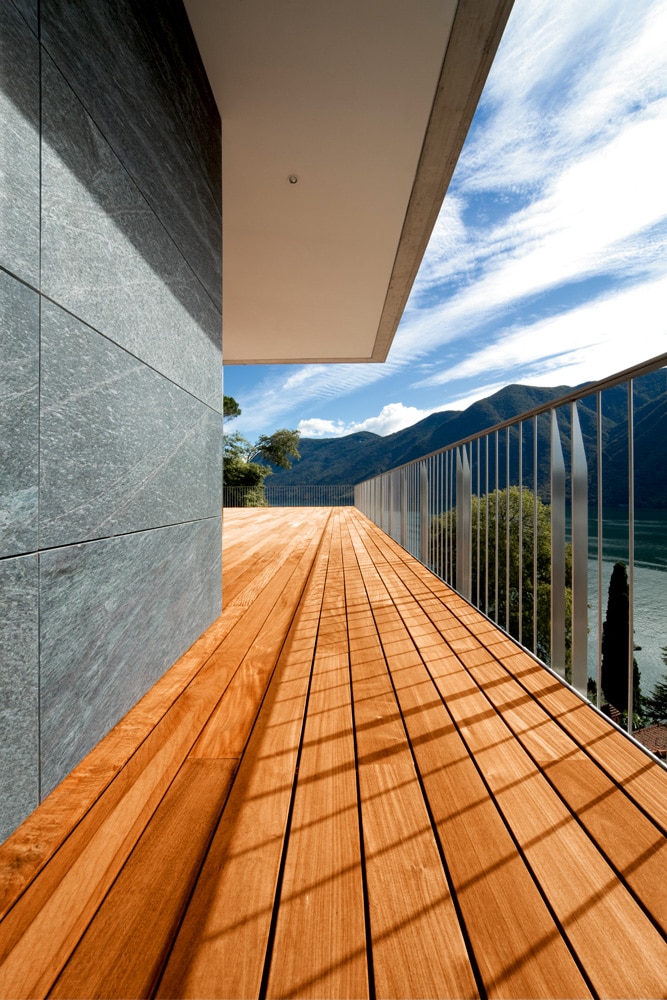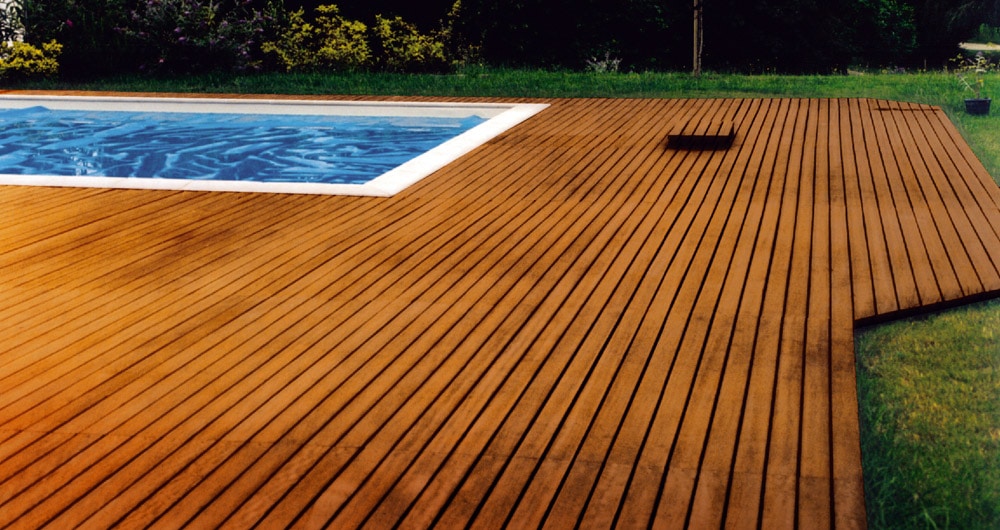This is the first post in a series that we will be running over the next few weeks in regards to helping you with choosing, installing and maintaining a garden deck. Today we will be explaining the main types of decking as well as giving you the pros and cons of each.
Pressure-Treated Softwood Decking
Around 75% of all new decking projects are created with this economical choice of timber. The two main benefits of this type of wood are its affordability and its ease of availability. Usually, pressure-treated softwood is made of pine which then has a treatment used on it to guard against things such as rot, fungus and wood-boring insects. It has a very characteristic green tinge to it and is widely used for decking all over the world.
The downside is its durability. It requires a lot more effort to preserve and protect the wood and is susceptible to damage such as splitting, cracking and warping. You will need to clean and preserve it every year, but if well looked after could last 30 years.
Naturally Durable Softwoods – Redwood & Cedar
These species of softwood contains oils and tannins that help prevent things such as rot, decay and insect attack. Because of this, they require much less maintenance and offer a much more natural aesthetic as there are no chemicals used on them. A redwood or cedar deck will usually only require a protective finish to be applied every 3 years or so.
However, it should be noted that they can be up to 3 times more expensive than pressure-treated wood.
Something else you should consider when choosing softwood is the quality of the wood. This will vary depending on where the wood grew on the tree. Heartwood is the wood that grows in the centre of the tree which contains a high level of tannins and oils. This means the wood will have more longevity. Sapwood is the wood that grows towards the outside of the tree and is softer and contains less tannins and oils. This means it is more susceptible to rot and decay.
Hardwood Decking
When it comes to hardwood decking, there is a wide variety of species of wood available. These include oak, ipe, mahogany, massaranduba and cumaru. As the name suggests, these woods are very hard and strong and are naturally resistant to rot, fungus and insect attack. Because of this, they require less maintenance to keep them protected from the elements.
On the downside, it should be noted that these woods are difficult to work with. You will notice this when it comes to drilling and cutting! Due to this difficulty, a lot of hardwood decks use a hidden clip and fastenings version of installation which can be expensive.
Hardwood decking is a more expensive option to pressure-treated timber but is comparable in costs to that of redwood or cedar. Due to hardwood being a dense substrate, you will need to use a specific finish designed for them. Products such as Textrol or Deks Olje D1 are perfect for all hardwoods.
Composite Wood Decking
This man-made material is becoming more and more popular and is a perfectly viable alternative to timber. Composite wood is made from a mixture of wood particles and plastic. Due to its composition, it is weather resistant and does not split, crack or splinter. It is also usually made from recyclable material and can be eco-friendly. Some companies create pure plastic decking so this is another option for you.
Composite wood decking is very easy to maintain and protect. All you will really need is a good quality cleaner and revived such as Compo-Clean and Compoxell. It’s imperative that you keep up with the cleaning maintenance though as composite wood is susceptible to mould and mildew. This is especially so in damp or shady spots.
Composite wood has the added benefit of being available in a wide variety of colours. This means no finish is required! Often the companies that manufacture composite wood also make balustrades, moulding and railings to match.
Just like timber decking, composite decking also swells when it gets wet. However, it does this along both the length and the width – something to be aware of if you are slotting your deck in around features!
However, be aware that composite decking does not really look like wood. At least, not like real wood! If having a natural-looking wood deck is important to you, then composite decking may be a miss.
Metal Decking
The most common type of metal decking is made from aluminium and it has a lot of positives. It’s both strong and lightweight, not prone to insect and water damage, can be cut easily and the boards slot together tightly creating a water-tight deck! This is a great option if you plan on a raised or second level deck where people may be sitting or walking below.
It also lasts pretty much forever. It doesn’t peel or blister and the powder-coated finish does not require treating.
However, it is very expensive! And similarly to composite decking, it does not have a natural wood aesthetic and so if that is important to you, this is not the material for you. It is an excellent statement piece though!
In our next post, we will be looking at the different ways you can treat your deck – be it brand new or weathered.
We hope you found this post helpful. If you have any other tips, tricks or advice, please feel free to leave them in the comments section below.
To keep up to date with all things Owatrol, why not follow us on our social media pages? You can find us on Facebook and Instagram @owatrolireland or at the hashtag #owatrolireland





Cost of building 3×3mts decking
Hi Michael,
Our advice would be to speak to a professional who will be able to advise you better.
All the best,
The Owatrol Team
Do you have a price list please
Hi Caroline,
We do not have a price list available but you will find prices on all our product pages.
All the best,
The Owatrol Team
Hope you can help. I need approx 60 feet of composite wood for a wheelchair ramp
Thank you
Marie O’Reilly
Hi there Marie,
Sadly we cannot assist you with this query as we do not stock these types of products. We recommend speaking with companies that stock composite wood for the best advice.
Apologies and best of luck with your ramp.
All the best,
The Owatrol Ireland Team
Hi I have a composite deck fitted over for 5 years it has some stains on it I am not too bothered about them I am just looking for some protection for it when it gets its yearly wash
Thanks Arthur Armstrong
Hi there Arthur,
We have a product named Compoxell that is a water-based coating for reviving all types of exterior composite wood. It enhances and revives the colour of the wood whilst also protecting it from stains and waterproofing the surface. It’s easy to apply with a brush or roller and only needs a single coat. It is a transparent tinted coating which is currently available in brown and grey and it gives a matt / matt sheen finish: https://www.owatrol.ie/product/compoxell/
We recommend applying this after it has had a deep clean and has thoroughly dried.
Please feel free to give us a call should you have any further queries: +353 1 830 2250 or send us an email to: info@igoe.ie
All the best,
The Owatrol Team